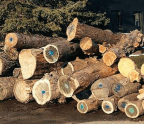
Precision measuring and marking tools, such as your trusty squares and various gauges, deserve a protected storage place when not in use. So do your fine-toothed handsaws and French curves or other layout tools to keep their edges and teeth in tiptop shape. That’s why I thought a special wall-mounted, double-door cabinet would be just the right home base for my “fine” tool collection. It has four shallow drawers, three of which are lined with foam organizers for those tools that don’t hang easily. Each door pocket holds larger but lightweight items with rare-earth magnets, so they’re easy to see and simple to access. And while my cabinet has two racks of chisels in the large upper compartment, you could outfit this area however you like. For instance, a till for your hand planes might better suit your storage needs.
I had some curly maple boards left over from another project years ago, so I’m putting that beautiful material to use here as showy door panels and for the four drawer faces. The rest of the cabinet is mostly made of hard maple, ½" plywood and ¼" MDF. But of course, feel free to use any solid wood or sheet stock that suits your tastes and budget for this project.

Building the Carcass and Doors
Let’s get this tool cabinet build underway by first ripping and crosscutting stock to size for the carcass top, bottom and sides, according to the Material List dimensions on page 31. Then rip stock to width for the four door rails and four stiles, and crosscut them to length.
Next, cut ½"-wide, ¾"-deep box joints into the carcass parts and door frame workpieces. You can carry out this joinery operation on the router table or at the table saw with a ½"-wide dado blade and a shop-made or commercial box joint jig. Notice in the on page 31 that the box joint pattern is unbroken from the back of






